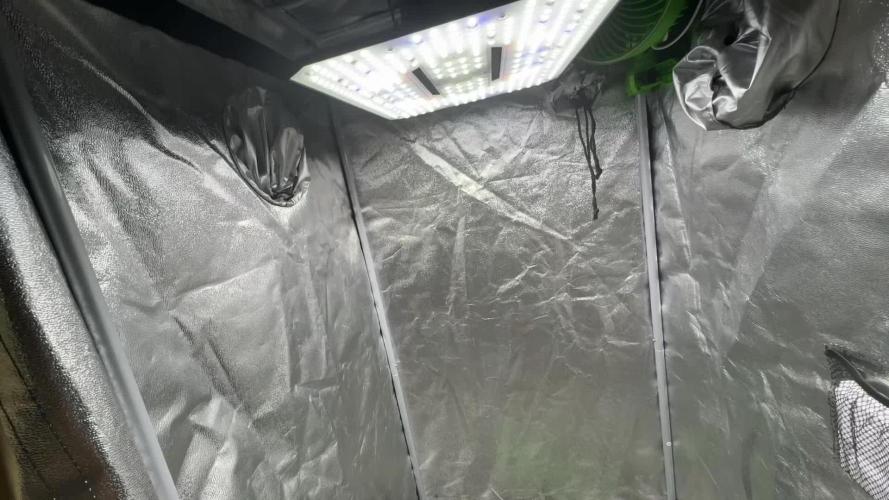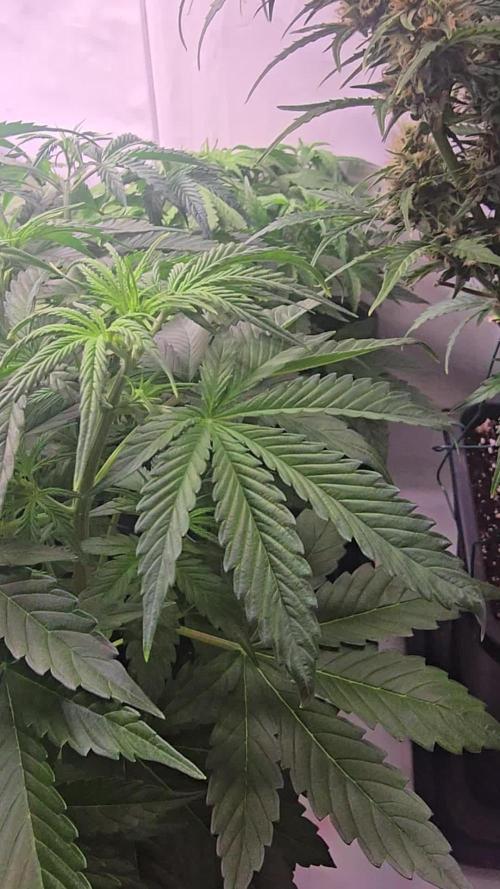The Grow Awards 2026 🏆 



























Likes
Comments
Share


@Sickone
Follow
Ab geht es in die 8. Woche.
Montag:
Die CalMag Lady macht einen überhaupt nicht vitalen Eindruck, jedoch kämpft sie dagegen an und streckt sich in die Höhe.
Alle Ladys wurden heute erneut gedüngt nach Düngschema allerdings ab jetzt ohne BioBizz Bio Grow aufgrund Empfehlung.
Likes
5
Share


@Ninjabuds
Follow
I moved my fastbuds plants under my new ELUFAH UAP-1500… from the start this light seems like it’s way more than 50 watts brighter than my other light. This light is going to be amazing. I’m already loving it. Can’t wait for grow pros to release more products from ELUFAH…
Papapayton is doing great it’s at that stage it’s about to explode in a week or so
Likes
4
Share


@Brothersfromweed420
Follow
Origen: Afganistán
Tipo: Indica / Sativa
Floración: 63 Días
THC: 29%
Cosecha: 400 g / m2
Altura: 150-205 cm
Clasificación:####

Divine Seeds desarrolló Opium como una nueva cepa campeona. Las variedades autóctonas más potentes y resinosas de Afghani Indica se crearon junto con una poderosa sativa brasileña, de la que Opium hereda su brillante sabor a bayas. El genotipo de Opium es un gran trabajo: los criadores estaban decididos a obtener el nivel más alto de THC, hacer que Opium fuera lo suficientemente fuerte para cualquier condición de cultivo y superar los límites de la productividad. Sus creadores describen Opium como la hierba con la que siempre soñaron cultivar.
En el interior, estas plantas se mantienen en su mayoría de altura media (1,5 m), alcanzando hasta 2,0 m en el exterior. Dependiendo de sus limitaciones de altura, Opium se puede cultivar universalmente en cajas de cultivo, balcones, invernaderos y terrazas. Debido a su ascendencia afgana, Opium puede soportar el clima cálido si se le proporciona suficiente agua y algo de sombra. Responde bien a cualquier técnica de entrenamiento: ScroG y SoG, LST, topping y FIM, supercropping. El inicio de la floración se marca con una oleada de crecimiento, cuando las plantas se estiran casi 1,5 veces. El opio desprende un penetrante hedor terroso con matices afrutados. Listo para cosechar en exterior en octubre.
El impacto psicodélico de lapidación con el que te golpea Opium es como estar hipnotizado. Lo suficientemente fuerte para matar los dolores, Opium también es médicamente eficaz contra el insomnio, las náuseas, los trastornos del apetito, los espasmos musculares, los dolores de cabeza, la irritación, la fatiga, los ataques de pánico y la epilepsia. El uso recreativo de Opium significa viajar silenciosamente de una visión a otra. Se consume mejor por la noche.
Likes
25
Share


@Kakui
Follow
Veg54, riego con 6.2 pH y EC 1.5, drenaje de 2.0 EC y pH 6.3, todo ok. Las plantas ya alcanzaron entre 25~30cm, en 2 días más comenzará la pre floración.
Veg56, están casi de 30 centímetros de altura, último día de vegetación, mañana entrarán a pre floración, necesitan una defoliación.
Likes
9
Share


@ThatsmyGrow
Follow
They look soo good and happy. I hope they get so big like my last Gorilla Cookies Auto
Likes
10
Share


@TiRobotProds
Follow
Bonjours à tous, nous entamons les deux dernières semaines de rinçage pour ces dames. La gorilla sherbet 1 a été récolter.
Likes
6
Share


@Staffedition
Follow
Привет друзья.
Наше знакомства продолжается с новым сортом автоцветущих растений от Smail_Seeds сорт TROPICANNA POISONZKITTLEZ XL AUTO F1 reg.
Сегодня растению 36 дня.
Растение очень хорошо развивается, ни каких сбоев в генетике не наблюдается.
Сорт выводим сами.
Смотри мой профиль, у нас всегда есть что то интересное.
Не забудь поставить лайк❤️, если понравилась как прошла неделя
И читайте наш TELEGRAM: https://t.me/smail_seeds
#Smail_Seeds 😀
Processing
Likes
10
Share


@mkrmkr
Follow
Completing the fiveteenth week.
Plant 1 - Completing the fiveteenth week of life.
Plant 2 - Completing the fourteenth week of life.
Plant 3 - Completing the fourteenth week of life.
KeepGrowing.......!
Likes
6
Share


@Weedganja420
Follow
Ha sido un cultivo facil y sin complicaciones, las plantas han respondido muy bien a el nuevo led.
Estoy muy contento con el resultado.
Repetiria esta cepa.
Likes
5
Share


@UhhDoiigreen
Follow
Last compost tea feeding tomorrow will be the end of week 7. I am very happy with this girl. She has massive sense even colas. She’s covered in 💎 and smells amazing. No issues of any kind. The last week and a half she’s only gotten organic teas and will only be given water for the next 7-10 days and then nothing till harvest with 36 hours of darkness
Likes
7
Share


@Brickie74
Follow
Well this is actually where i started. I had already germinated the Green Tea (Forbidden Fruit x Gelato) seed. Now i think i am caught up. I will try to post as many videos as possible. I suck at typing and with the dictation it takes longer to fix the f_ck ups than to just type what I wanted. I can just explain what I'm doing or what I've done for the week. This is my first ever grow journal so it may be all over the place....we will see.....
I have multiple grows happening at the same time....sometimes I get carried away...lol....and might have a few more than I expected to have. I will do my best to keep things up to date and current. I definitely want to start running right out of the gate and make a pretty decent journal.
Likes
5
Share


@Ninjabuds
Follow
Obama runtz x gas tax sad to say both seedlings are super crappy so far. If it was not for the gas tax parent being the best flower ever then I wld just toss these but sometimes the crappy slow growing plants end up being super dank
It's looking like a good start to a week the plants are strong they are getting to the point I can let the dried dry out completely. I'm thinking by the end of this week the plants will be starting to be sold.
Last week I put all the plants into my bigger 2x4 tent with my medicgrow mini sun 2 the 500w version. Only a few of the plants were ready for that light. Seems like the only plants that really have good resistance and have a strong start are the weedseedsexpress.com seeds. Shout out to weedseedsexpress.com for the strong plants.
I ended up putting all the plants back into my 2x2 tent with the 55w amazon light it has alot more blue light in its spectrum. It's kinda weird b4 I switched the plants to the 2x4 tent they were getting 220umol under my amazon 55w led then when I put them under the 500w light 25% strength about 50in from plants and they were getting only about 195umol in that tent but it was stressing most the plants. I assume a larger light has more side lighting hitting the plants. I think when useing larger lights it's good to measure umols from the top but also coming from the sides. I think durring seedling stage they only need about 50% the umols coming from the side the plants as the top is receiving.
When I put the plants back in the small tent about the same umols as they were getting b4 the switch and they were still a little stressed. So for a few days I put the small light at the top the tent giving them 100umols for a few hrs then 130umols the rest the day.
Likes
3
Share


@LonelyStonerz
Follow
Transplanted two more of these blueberry autos into 5gal buckets. Did some training on one and am going to leave the rest. I took that video yesterday check out the REBOUND one day later, clearly NO transplant stress whatsoever!
Processing
Likes
150
Share


@Teamdirtbag2
Follow
AvT oh my she just stinks and I'm not sure is a pleasant smell. She is 22 inches tall and just as wide, filling her space nicely. Defoleated her. She is bottom heavy, branches are low and wide. Hung second light so things should be happening. Increased newts to 680 ppm. All things considered this plant is doing great, and really has a strong smell.
























